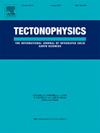Crustal silica content of East China: A seismological perspective and its significance
IF 2.7
3区 地球科学
Q2 GEOCHEMISTRY & GEOPHYSICS
引用次数: 0
Abstract
East China has experienced multiple periods of tectonic movements, which have contributed to the composition and rheological properties of its present crust. Estimating the composition of the crust is crucial for understanding the tectonic processes. Based on the teleseismic receiver functions with data from the National Seismic Network of China, we applied the H-κ-c method to obtain the crustal bulk VP/VS ratio and to constrain the SiO2 content in the crust. We estimated the SiO2 content to range from 50.89 wt% to 73.51 wt%, with an average value of 65.87 wt%, indicating a predominant felsic composition of the East China's crust. Our study suggests that the North-South Gravity Lineament (NSGL) is an approximate delimitator of the felsic and mafic crust in East China, hinting at a widespread deficiency of mafic lower crust in the east of the NSGL. The mafic crust is extensively distributed in the Taihang orogenic region (TSR) and WuLingshan gravity gradient belts (WLG), particularly in the Datong volcanic area, which manifests the mantle materials intraplating. The scatteredly distributed mafic crust at the east of the NSGL is mainly concentrated in the southeast coast of China and in the intersection region of the Tanlu Fault (TLF) and Sulu region. In Sulu region, the TLF may primarily provide a channel for the thermal intrusion from the underlying mantle lithosphere, which has increased the mafic content. The Pacific/Philippine Sea plate subduction has triggered a significant amount of crust-mantle material exchange below southeast China that resulted in a high degree of mafic crustal composition.
华东地壳硅含量:地震学视角及其意义
华东地区经历了多个时期的构造运动,形成了现在的地壳成分和流变特性。估算地壳的组成对于了解构造过程至关重要。基于中国国家地震台网数据的远震接收函数,我们应用H-κ-c方法获得了地壳体积VP/VS比,并对地壳中的SiO2含量进行了约束。我们估计地壳中SiO2的含量范围为50.89 wt% 至 73.51 wt%,平均值为65.87 wt%,表明华东地壳的主要成分为熔岩。我们的研究表明,南北重力线是华东地区长岩地壳和黑云母地壳的近似分界线,暗示南北重力线以东地区普遍缺乏黑云母下地壳。黑云母地壳广泛分布于太行造山带和武陵山重力梯度带,特别是大同火山区,表现为地幔物质内镀。国家南极重力梯度带东侧零星分布的黑云母地壳主要集中在中国东南沿海和郯庐断裂(TLF)与苏禄地区的交汇区。在苏禄地区,郯庐断层可能主要为来自下伏地幔岩石圈的热侵入提供了通道,从而增加了岩浆岩的含量。太平洋/菲律宾海板块俯冲在中国东南部下方引发了大量的地壳-地幔物质交换,造成了高度的岩浆地壳成分。
本文章由计算机程序翻译,如有差异,请以英文原文为准。
求助全文
约1分钟内获得全文
求助全文
来源期刊

Tectonophysics
地学-地球化学与地球物理
CiteScore
4.90
自引率
6.90%
发文量
300
审稿时长
6 months
期刊介绍:
The prime focus of Tectonophysics will be high-impact original research and reviews in the fields of kinematics, structure, composition, and dynamics of the solid arth at all scales. Tectonophysics particularly encourages submission of papers based on the integration of a multitude of geophysical, geological, geochemical, geodynamic, and geotectonic methods
 求助内容:
求助内容: 应助结果提醒方式:
应助结果提醒方式:


